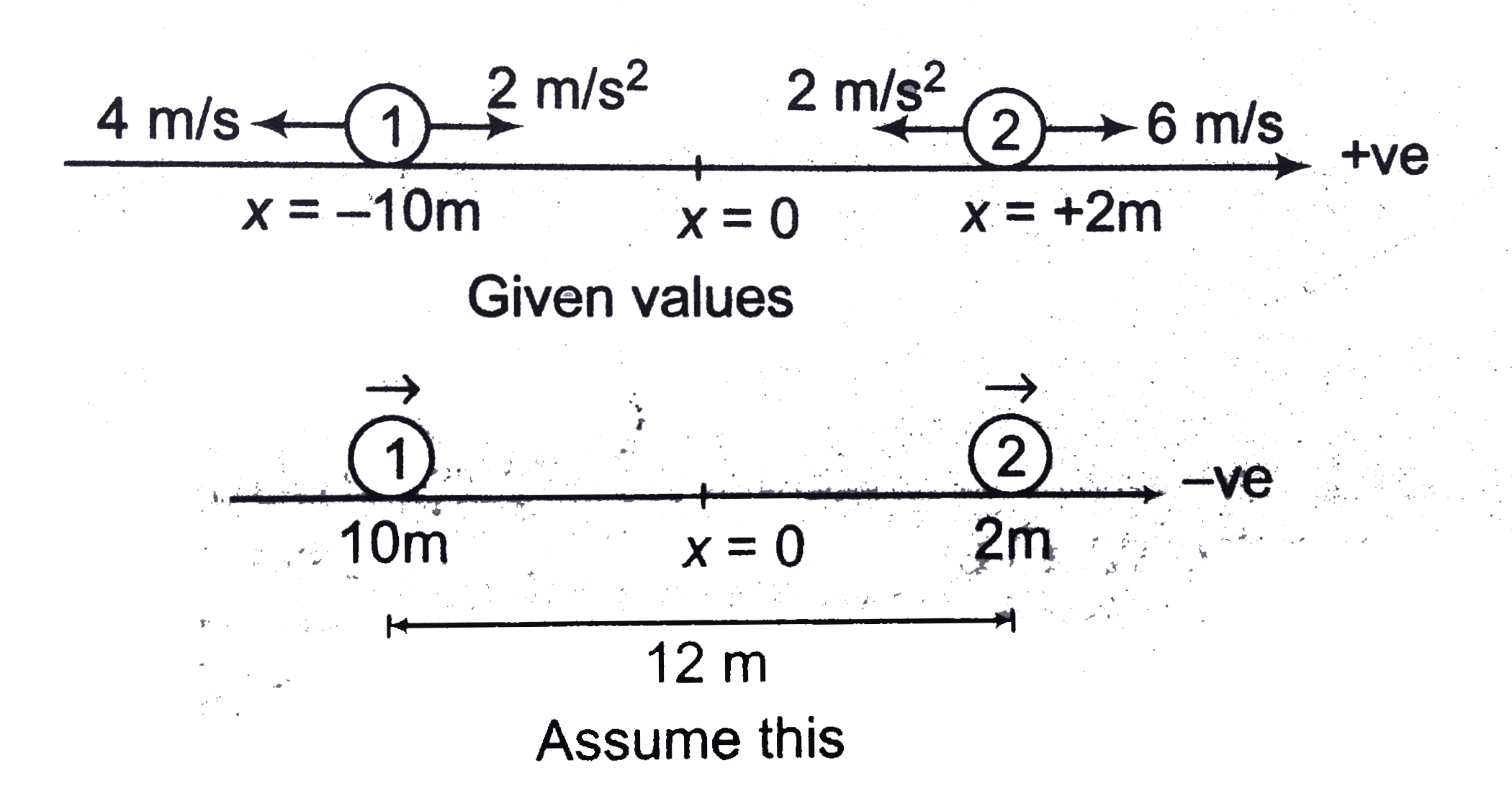Two particles are moving along x-axis. Particle-1 starts from `x=-10 m` with velocity `4 m//s` along negative x-direction and acceleration `2 m//s^2` along positive x-direction. Particle-2 starts from `x=+2 m` with velocity `6 m//s` along positive x-direction and acceleration `2 m//s^2` along negative x-direction.
(a) Find the time when they collide.
(b) Find the x-coordinates where they collide. Both start simultaneously.
Two particles are moving along x-axis. Particle-1 starts from `x=-10 m` with velocity `4 m//s` along negative x-direction and acceleration `2 m//s^2` along positive x-direction. Particle-2 starts from `x=+2 m` with velocity `6 m//s` along positive x-direction and acceleration `2 m//s^2` along negative x-direction.
(a) Find the time when they collide.
(b) Find the x-coordinates where they collide. Both start simultaneously.
(a) Find the time when they collide.
(b) Find the x-coordinates where they collide. Both start simultaneously.
Text Solution
Verified by Experts
The correct Answer is:
A, B
(a) 
Particle-1 is behind the particle-2 at a distance of `12 m`. So, particle-1 will collide particle-2, if
`S_1=S_2+12 rArr :. u_1t+1/2a_1t^2=u_2t+1/2a_2t^2+12`
But now we will substitute the values of `u_1,u_2, a_1` and `a_2` with sign
`:. (-4)t+1/2(+2)t^2=(+6)t+1/2(-2)t^2+12`
Solving this equation, we get positive value of time,
`t=6s`
(b) At the time of collision, `S_1=u_1t+1/2a_1t^2=(-4)(6)+1/2(+2)(6)^2=+12 m`
At the time of collision, x-coordinate of particle`-1:`
`x_1=("Initial x-coordinate of particle-1")+S_1`
` = -10+12=+2m`
Since, they collide at the same point. Hence,
`x_2 = x_1 = +2m`

Particle-1 is behind the particle-2 at a distance of `12 m`. So, particle-1 will collide particle-2, if
`S_1=S_2+12 rArr :. u_1t+1/2a_1t^2=u_2t+1/2a_2t^2+12`
But now we will substitute the values of `u_1,u_2, a_1` and `a_2` with sign
`:. (-4)t+1/2(+2)t^2=(+6)t+1/2(-2)t^2+12`
Solving this equation, we get positive value of time,
`t=6s`
(b) At the time of collision, `S_1=u_1t+1/2a_1t^2=(-4)(6)+1/2(+2)(6)^2=+12 m`
At the time of collision, x-coordinate of particle`-1:`
`x_1=("Initial x-coordinate of particle-1")+S_1`
` = -10+12=+2m`
Since, they collide at the same point. Hence,
`x_2 = x_1 = +2m`
Topper's Solved these Questions
Similar Questions
Explore conceptually related problems
Two particles are moving along x-axis. Particle-1 is 40 m behind Particle-2. Particle-1 starts with velocity 12 m//s and acceleration 4 m//s^2 both in positive x-direction. Particle-2 starts with velocity 4 m//s and acceleration 12 m//s^2 also in positive x-direction. Find (a) the time when distance between them is minimum. (b) the minimum distacne between them.
A particle is given velocity 3 m//s along the positive x-axis subjected to constant accelaration 4 m//s^(2) along the positive y-axis. Find the distaplacement of the particle in 2 s and trajectory followed by the particle.
A particle starts from rest at the origin and moves along the positive x direction. Its acceleration a versus position x graph is shown in the figure. The velocity of the particle at x = 6 m is?
A particle is moving along a straight line along x-zxis with an initial velocity of 2 m//s towards positive x-axis. A constant acceleration of 0.5 m//s^(2) towards negative x-axis starts acting on particle at t=0 . Find velocity (in m//s ) of particle at t=2 s .
A particle is given velocity 4 m//s along the positive y-axis subjected to constant accelaration 10 m//s^(2) at 53^(@) with the x-axis. Find the distaplacement of a particle along the coordinate axes after 3 s .
A proton is moving along the negative direction of X-axis in a magnetic field directed along the positive direction of Y-axis. The proton will be deflected along the negative direction of
The acceleration of a particle moving along x-axis is given by a = 6t. Initially it has a velocity of 4m//s along negative x-direction and it is at the origin. When will it return to the origin (in sec.)?
The position of a particle moving along x-axis varies eith time t as x=4t-t^(2)+1 . Find the time interval(s) during which the particle is moving along positive x-direction.
The position of particle moving along the x-axis veries with time t as x=6t-t^(2)+4 . Find the time-interval during which the particle is moving along the positive x-direction.
Knowledge Check
Two particles are moving along x-axis. Particle-1 is 40 m behind Particle-2. Particle-1 starts with velocity 12 m//s and acceleration 4 m//s^2 both in positive x-direction. Particle-2 starts with velocity 4 m//s and acceleration 12 m//s^2 also in positive x-direction. Find (a) the time when distance between them is minimum. (b) the minimum distacne between them.
Two particles are moving along x-axis. Particle-1 is 40 m behind Particle-2. Particle-1 starts with velocity 12 m//s and acceleration 4 m//s^2 both in positive x-direction. Particle-2 starts with velocity 4 m//s and acceleration 12 m//s^2 also in positive x-direction. Find (a) the time when distance between them is minimum. (b) the minimum distacne between them.
A
`1 s` `36 m`
B
`12 s` `36 m`
C
`1 s` `360 m`
D
`1 s` `136 m`
The acceleration of a particle moving along x-axis is given by a = 6t. Initially it has a velocity of 4m//s along negative x-direction and it is at the origin. Then select correct options.
The acceleration of a particle moving along x-axis is given by a = 6t. Initially it has a velocity of 4m//s along negative x-direction and it is at the origin. Then select correct options.
A
With in 2 sec is will return to origin.
B
With in 2 sec it will cover `((32)/(3sqrt(3)))` m distance
C
It's velocity when it return back to origin will be `8 m//s`
D
None of these
A proton is moving along the negative direction of X-axis in a magnetic field directed along the positive direction of Y-axis. The proton will be deflected along the negative direction of
A proton is moving along the negative direction of X-axis in a magnetic field directed along the positive direction of Y-axis. The proton will be deflected along the negative direction of
A
X-axis
B
Y-axis
C
Z-axis
D
None of these